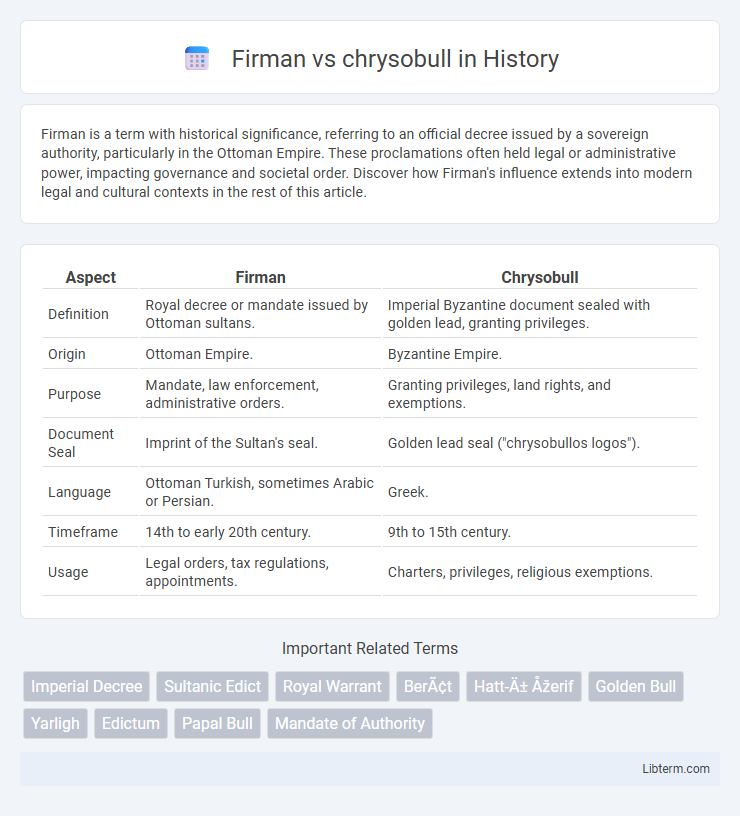Firman is a term with historical significance, referring to an official decree issued by a sovereign authority, particularly in the Ottoman Empire. These proclamations often held legal or administrative power, impacting governance and societal order. Discover how Firman's influence extends into modern legal and cultural contexts in the rest of this article.
Table of Comparison
| Aspect | Firman | Chrysobull |
|---|---|---|
| Definition | Royal decree or mandate issued by Ottoman sultans. | Imperial Byzantine document sealed with golden lead, granting privileges. |
| Origin | Ottoman Empire. | Byzantine Empire. |
| Purpose | Mandate, law enforcement, administrative orders. | Granting privileges, land rights, and exemptions. |
| Document Seal | Imprint of the Sultan's seal. | Golden lead seal ("chrysobullos logos"). |
| Language | Ottoman Turkish, sometimes Arabic or Persian. | Greek. |
| Timeframe | 14th to early 20th century. | 9th to 15th century. |
| Usage | Legal orders, tax regulations, appointments. | Charters, privileges, religious exemptions. |
Introduction to Firman and Chrysobull
Firman and chrysobull are distinct types of official documents used in Ottoman and Byzantine administrations, respectively. A firman is an imperial decree issued by the Ottoman sultan, granting orders, privileges, or authorizations, often concerning administrative or legal matters. Chrysobull, meaning "golden seal," refers to a Byzantine imperial charter sealed with gold, used to confer lands, privileges, or rights to individuals or institutions.
Historical Context of Firman and Chrysobull
Firmans and chrysobulls served as vital administrative documents in Ottoman and Byzantine empires, respectively, shaping governance through formalized decrees and privileges. The firman functioned as an imperial mandate issued by Ottoman sultans, granting authority, land rights, and legal permissions, playing a key role in consolidating central power during the empire's expansion from the 14th century onward. Chrysobulls, produced from the 11th to 15th centuries, were golden-sealed Byzantine imperial charters that conferred privileges to individuals, institutions, or territories, reflecting the empire's complex legal and social hierarchy prior to Ottoman dominance.
Definition and Origins of Firman
A firman is an authoritative decree or royal mandate issued by a sovereign in the Ottoman Empire, serving as a formal command or grant of privileges. Originating from Persian administrative practices, firmans were used extensively from the 14th century to regulate governance, land tenure, and taxation within the empire. Unlike a chrysobull, which is a Byzantine imperial edict sealed with gold, firmans typically bore the sultan's tughra and were written on paper or parchment to authenticate legal and administrative orders.
Definition and Origins of Chrysobull
A chrysobull is a Byzantine imperial decree sealed with a golden bulla, originating in the early Middle Ages as a formal document granting privileges or land. In contrast, a firman is an official Ottoman imperial mandate or royal decree issued by the sultan. The chrysobull's origins trace back to the Byzantine Empire's effort to authenticate and legitimize important administrative and legal orders through these distinguished golden seals.
Legal Authority and Purpose: Firman vs Chrysobull
Firman and Chrysobull served as distinct legal instruments with differing authorities and purposes during their respective periods. A Firman, issued by a Sultan or Ottoman ruler, acted as an authoritative decree or order, often related to governance, administration, or taxation within the Ottoman Empire. In contrast, a Chrysobull, primarily used in Byzantine and medieval Eastern European contexts, functioned as a formal charter or grant, typically conferring privileges, land rights, or exemptions to individuals, religious institutions, or cities.
Geographical Usage: Ottoman vs Byzantine Empires
Firmans were official decrees issued by the Ottoman sultans, predominantly used throughout the vast territories of the Ottoman Empire, including the Middle East, North Africa, and the Balkans. In contrast, chrysobulls were imperial Byzantine documents issued primarily within the boundaries of the Byzantine Empire, centered around Constantinople and its surrounding regions. The geographical usage of firmans and chrysobulls reflects the distinct administrative and cultural domains of the Ottoman and Byzantine empires during their respective eras.
Administrative Differences Between Firman and Chrysobull
Firman and chrysobull differ significantly in their administrative roles within the Ottoman and Byzantine empires, respectively. A firman was an official decree issued by the Ottoman sultan, often concerning governance, appointments, or legal matters, reflecting centralized authority in Ottoman administration. In contrast, chrysobulls were imperial edicts sealed with gold, primarily used in the Byzantine Empire to grant privileges or confirm rights, emphasizing ceremonial legitimacy over daily administrative functions.
Impact on Society and Governance
The firman, an official decree issued by Ottoman sultans, centralized authority by clearly defining administrative orders and legal rulings, thereby reinforcing the Sultan's control over governance and social norms. Chrysobulls, Byzantine imperial edicts often granted privileges to religious institutions or cities, shaping societal hierarchy and local governance by bestowing economic and legal exemptions that influenced power structures. Both documents significantly impacted societal organization and governance by formalizing authority and rights, but firmans promoted centralized governance across the empire, while chrysobulls often bolstered localized autonomy under imperial patronage.
Notable Examples in History
The Firman of Sultan Suleiman the Magnificent in 1541 granted privileges to French merchants, exemplifying the use of firmans in Ottoman diplomacy and trade regulation. The Chrysobull of Byzantine Emperor Alexios I Komnenos in 1082 awarded tax exemptions and commercial rights to the Republic of Venice, highlighting the document's role in medieval diplomatic and economic agreements. Both documents served as authoritative decrees that shaped political and economic relations between empires and foreign entities.
Lasting Legacy and Modern Relevance
Firman and chrysobull represent authoritative decrees from Ottoman and Byzantine empires respectively, establishing precedents in governance and legal frameworks. Their lasting legacy is evident in contemporary administrative practices that emphasize sovereign endorsement in legal and property rights documentation. Modern relevance persists through their influence on diplomatic protocols and the codification of privileges in statecraft and historical continuity.
Firman Infographic

 libterm.com
libterm.com